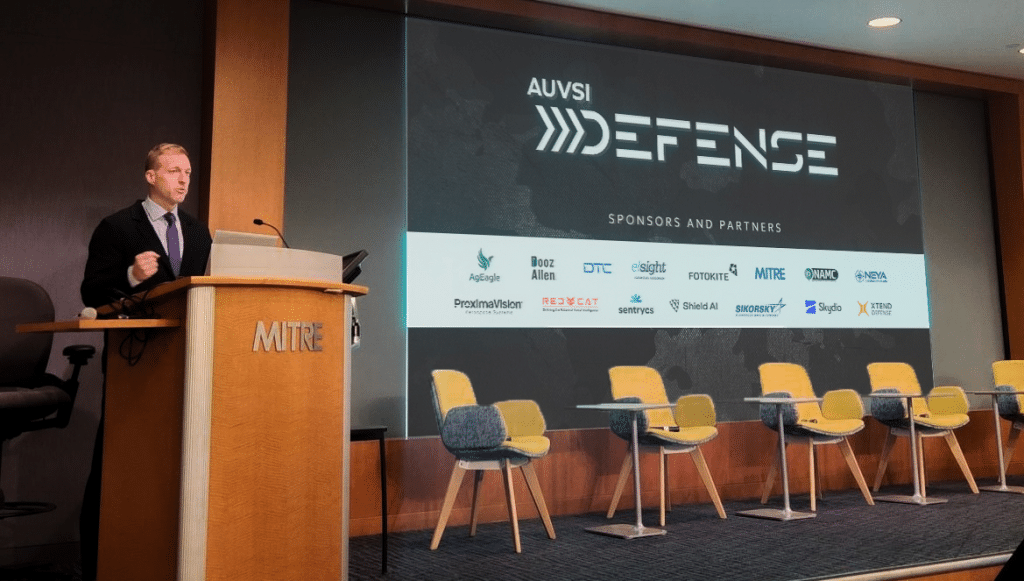Uncrewed Arsenal, for Democracy
October 23, 2024

Good Morning.
Thank you for joining us at AUVSI Defense, part of an ongoing series of thought leadership events that AUVSI has been hosting over the past several years.
I want to thank our sponsors for their support in helping us host this event – AgEagle, Booz Allen, Domo Tactical, Elsight, Fotokite, Lockheed Martin – Sikorsky, National Advanced Mobility Consortium (NAMC), Neya Systems, ProximaVision, Red Cat, Sentrycs, Shield AI, Skydio, and XTEND.
At our AUVSI Defense event here in February, we had 4 sponsors. Today, we have 14. I am very proud of the growth of this event in such a short time. I appreciate our sponsors recognition of AUVSI’s recent evolution, and our very conscious pivot to focus significantly more of our advocacy and thought leadership on defense and national security issues, which is critical not only for our members and the warfighters they serve, but for the future of democratic societies around the world.
I also want to thank our host – the MITRE Corporation – for allowing us to use your amazing facility. We appreciate the partnership between AUVSI and MITRE, and the great work we do together for our warfighters and to advance AUVSI member technologies in all domains in the commercial, civil, and defense sectors.
Today, we come together at a pivotal moment to discuss AUVSI’s role in leading the autonomous and uncrewed systems industry forward, particularly in support of the U.S. Department of Defense’s (DoD) mission.
Our objective is clear: ensuring that our warfighters, and those of our allies, have the tools they need to deter war, or fight and win tonight if necessary.
When we last convened here for the AUVSI Defense event in February, I focused heavily on the INDOPACOM AOR, highlighting the strategic competition between the U.S. and the People’s Republic of China.
From small drones to highly capable warships, the PRC is building military assets at a pace that leaves the U.S. and our allies facing a severe disadvantage. This is a national security threat that demands urgent, whole-of-government action.
Multiple unclassified war games have demonstrated that the U.S., and our allies, lack the volume of platforms and weapons needed to compete in the South China Sea or in other conflict zones, especially if multiple conflicts are occurring at once.
Without going into detail, as it stands today, it is widely understood that many of our current platforms – subs, ships, airplanes, and drones – will be Winchester within the early days, or even hours, of a western Pacific conflict.
INDOPACOM Commander, Admiral Paparo, has repeatedly sounded this alarm, as did his predecessor Admiral Aquilino. Their battlefield vision is one of asymmetric warfare, where swarms of all domain drones combine with more traditional military platforms to create a Hellscape for our adversaries. For this to be successful, being out of ammo in the first few days is not an option.
Planning for Hellscape, and learning lessons from the illegal war in Ukraine, the conflict between Israel, Iran and terrorist groups, and the Houthi missile attacks in the Red Sea, it has become very clear that modern, high-intensity conflict expends large volumes of munitions and weapons, including uncrewed systems, very rapidly.
We must learn from the global landscape – from the decks of DDGs in the Red Sea taking out Houthi missiles and Iranian drones with SM-2s to the front lines of Ukraine where electronic and autonomous warfare are evolving daily – and adapt much more quickly.
Which brings us to our challenges:
Today, the industrial base necessary to support rapid arming and rearming is not where we need it to be.
The acquisition system does not support rapid evolution of technology.
And the funding for the acquisition systems needed for modern warfare is not there yet.
A draft of the National Defense Industrial Strategy rightly noted that our defense industrial base “does not possess the capacity, capability, responsiveness, or resilience required to satisfy the full range of military production needs at speed and scale.” This is true for drones, long-range precision munitions, shipbuilding, and more throughout our defense industry.
As Skydio’s Mark Valentine noted during a recent House Armed Services Committee hearing, “More is more. In wars of technology attrition, the side that has access to, and the capability to build drones and autonomous systems at scale gains a strategic advantage.” Yet, without a focused effort to close the funding gap between research, development, and actual acquisition, the U.S. risks falling even further behind in this critical area.
The solution requires a shift in how we approach defense acquisition. As Shield AI’s Brandon Tseng stated in the same Congressional hearing, we must transition from a requirements-based acquisition system to a problem-based acquisition system.
Instead of rigidly adhering to pre-set requirements, the DoD should work closely with industry to define the most pressing problems faced by warfighters, then let the private sector innovate solutions. This would allow industry to move faster, innovate more freely, and respond directly to the needs of the battlefield.
The Army made some news last week noting that they are looking to change the way they think about acquisitions for drones, counter-UAS, and for electronic warfare. Instead of the 2-3 year planning and programming for specific requirements, which leads to technology that is outdated by the time the plans are finalized and certainly long before acquired, the Army intends to ask Congress for bundled dollars. And trust. Trust that the Army can pick the correct, innovative solutions the warfighter needs and get them into the field faster.
This is an innovative, solution-based approach that could be one the keys to keeping up with the pace of technology and warfare. We’ll be watching to see how the Army moves forward, and how this works. This might indeed be a way of rapidly integrating new technology, at least in theory. In fact, it sounds a lot like Replicator and the funding provided to DIU.
Replicator, as I’ve discussed at length at the previous two AUVSI Defense events, is another step in the right direction. Replicator is an initiative, or an idea – not a program – to help us learn how to achieve integration goals, and to focus attention on key advanced technologies, starting first with autonomous technology. Replicator 2 will focus on counter UAS systems.
From what we have seen over the first year, there has been some early success with the rapid acquisition of attritable air and maritime autonomous systems. We are very proud of the leadership role AUVSI has played working with OSD and DIU to help shape Replicator outcomes by facilitating information sharing and dialogue between industry and the DoD. AUVSI has also aggressively lobbied for enhanced funding for Replicator acquisitions.
Last month, at a Congressional hearing on the findings of the Commission on the National Defense Strategy, AUVSI called on the DoD to evolve the Replicator initiative into an acquisition process that accelerates the deployment of uncrewed systems to the warfighter.
Because let’s be clear, when we are successful, we’ll be providing our warfighters with tools that are:
- Low cost
- Attritable
- Unpredictable
- Capable of overwhelming the opponents Anti Access Area Denial (A2AD) systems
- Maintain a low logistics footprint
- Can be independent from bases, anywhere in the world
- And have minimal C2 with reliance on AI and hardened cyber security
With both Replicator and the acquisition changes the Army is discussing, and other early initiatives with other service branches, we see promise. We also know that the defense industry needs levels of certainty to attract investments to scale production and workforce.
Accordingly, we need to start placing orders. The reality is that due to inconsistent demand from the DoD, companies in the autonomous technology space struggle to scale production. As Shield AI’s Tseng put it, “Today, autonomy is funded at levels that lack credibility or seriousness.”
Without actual orders, companies cannot build the supply chains, workforce, or production capacity needed to scale.
By placing large-scale orders for autonomous systems – not only for U.S. warfighters but for arming our allies as well – the DoD could help address the production scaling challenge. This would also send a strong deterrence signal to our adversaries, showing that the U.S. is ready and capable of meeting the demands of modern warfare.
To illustrate the urgency of this effort, I recently revisited the book Freedom’s Forge, which recounts the incredible mobilization of American industry during World War II.
It’s an inspirational book about the power of industry to help win a world war. If you have not read the book, or read it recently, it’s worth your time.
Learning from the lessons of World War I, when the U.S. was inadequately prepared to arm its European allies and American troops once the U.S. entered the war, there was a massive public-private collaborative effort leading into WWII to revitalize American industrial defense capacity.
Building new capacity and converting civilian factories to produce military equipment, the U.S. industrial based worked overtime to ensure a rapid and efficient production process to streamline the manufacturing of aircraft, tanks, and munitions.
This strategic mobilization of resources and industrial capabilities significantly bolstered the U.S. military readiness and contributed to the Allied powers’ success in World War II. You know it as the Arsenal of Democracy.
Today, the U.S. must rapidly undertake a similar effort to encourage deterrence by showcasing our industrial might. We must scale production of uncrewed systems, and globally preposition UAS, UUV, USVs, and UGVs, along with accompanying components and weapon systems, to deter aggression and to be prepared to fight and win.
We need an Uncrewed Arsenal, for Democracy.
The path forward is clear: we must reform acquisition to focus on solving problems, not just fulfilling requirements. We must place real orders to allow industry to scale, and we must align our technological capabilities with the realities of modern warfare.
The future of defense will be driven by autonomous systems, and AUVSI, as the tip of spear for our members, is committed to leading the way.
Together, we can ensure that our warfighters will have the tools they need to succeed. There is no other option. Thank you.


